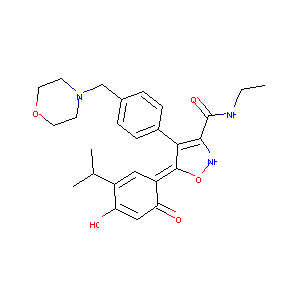| DOT Name |
DOT ID |
UniProt ID |
Mode of Action |
REF |
|
Anterior gradient protein 2 homolog (AGR2)
|
OTRRZT7W
|
AGR2_HUMAN
|
Increases Expression
|
[5] |
|
Epidermal growth factor receptor (EGFR)
|
OTAPLO1S
|
EGFR_HUMAN
|
Decreases Expression
|
[7] |
|
Fibroblast growth factor 1 (FGF1)
|
OT8I64X8
|
FGF1_HUMAN
|
Decreases Expression
|
[5] |
|
ATP synthase subunit beta, mitochondrial (ATP5F1B)
|
OTLFZUQK
|
ATPB_HUMAN
|
Decreases Expression
|
[5] |
|
Insulin-like growth factor 1 receptor (IGF1R)
|
OTXJIF13
|
IGF1R_HUMAN
|
Decreases Expression
|
[7] |
|
Hepatocyte growth factor receptor (MET)
|
OT7K55MU
|
MET_HUMAN
|
Decreases Expression
|
[7] |
|
Platelet-derived growth factor receptor beta (PDGFRB)
|
OTYSNK9Q
|
PGFRB_HUMAN
|
Decreases Expression
|
[7] |
|
Poly polymerase 1 (PARP1)
|
OT310QSG
|
PARP1_HUMAN
|
Increases Cleavage
|
[7] |
|
Heat shock 70 kDa protein 1A (HSPA1A)
|
OTKGIE76
|
HS71A_HUMAN
|
Increases Expression
|
[5] |
|
Mast/stem cell growth factor receptor Kit (KIT)
|
OTHUY3VZ
|
KIT_HUMAN
|
Decreases Expression
|
[7] |
|
S-formylglutathione hydrolase (ESD)
|
OTUSIBPS
|
ESTD_HUMAN
|
Increases Expression
|
[5] |
|
Elongation factor 2 (EEF2)
|
OTZ7SZ39
|
EF2_HUMAN
|
Increases Expression
|
[5] |
|
Pyruvate kinase PKM (PKM)
|
OTLHHMC2
|
KPYM_HUMAN
|
Decreases Expression
|
[5] |
|
Serine/threonine-protein kinase B-raf (BRAF)
|
OT7S81XQ
|
BRAF_HUMAN
|
Decreases Expression
|
[7] |
|
NAD(P)H dehydrogenase 1 (NQO1)
|
OTZGGIVK
|
NQO1_HUMAN
|
Decreases Expression
|
[5] |
|
Intron Large complex component GCFC2 (GCFC2)
|
OTC7FRXL
|
GCFC2_HUMAN
|
Increases Expression
|
[5] |
|
Proteasome subunit alpha type-1 (PSMA1)
|
OTNBVM2U
|
PSA1_HUMAN
|
Increases Expression
|
[5] |
|
NF-kappa-B inhibitor alpha (NFKBIA)
|
OTFT924M
|
IKBA_HUMAN
|
Affects Phosphorylation
|
[7] |
|
M-phase inducer phosphatase 3 (CDC25C)
|
OTPQI71S
|
MPIP3_HUMAN
|
Decreases Expression
|
[7] |
|
RAC-alpha serine/threonine-protein kinase (AKT1)
|
OT8H2YY7
|
AKT1_HUMAN
|
Decreases Expression
|
[7] |
|
Radixin (RDX)
|
OTNSYUN6
|
RADI_HUMAN
|
Increases Expression
|
[5] |
|
Caspase-3 (CASP3)
|
OTIJRBE7
|
CASP3_HUMAN
|
Increases Cleavage
|
[7] |
|
Serpin H1 (SERPINH1)
|
OTKGI7BS
|
SERPH_HUMAN
|
Decreases Expression
|
[5] |
|
Small ubiquitin-related modifier 3 (SUMO3)
|
OTTUJQJ1
|
SUMO3_HUMAN
|
Decreases Expression
|
[5] |
|
Peptidyl-prolyl cis-trans isomerase A (PPIA)
|
OTHJMWQQ
|
PPIA_HUMAN
|
Increases Expression
|
[5] |
|
Echinoderm microtubule-associated protein-like 5 (EML5)
|
OT0EFCPB
|
EMAL5_HUMAN
|
Increases Expression
|
[5] |
|
Interleukin enhancer-binding factor 3 (ILF3)
|
OTKMZ5K5
|
ILF3_HUMAN
|
Decreases Expression
|
[5] |
|
Eukaryotic translation initiation factor 3 subunit I (EIF3I)
|
OTE07WND
|
EIF3I_HUMAN
|
Decreases Expression
|
[5] |
|
3-hydroxyacyl-CoA dehydrogenase type-2 (HSD17B10)
|
OT7RJON4
|
HCD2_HUMAN
|
Decreases Expression
|
[5] |
|
Phenylalanine--tRNA ligase beta subunit (FARSB)
|
OT8N9TT5
|
SYFB_HUMAN
|
Increases Expression
|
[5] |
|
Protein PALS2 (PALS2)
|
OTV12NKE
|
PALS2_HUMAN
|
Increases Expression
|
[5] |
|
Cingulin (CGN)
|
OTBCQ8AQ
|
CING_HUMAN
|
Decreases Expression
|
[5] |
|
Poly polymerase 2 (PARP2)
|
OTYL81ZI
|
PARP2_HUMAN
|
Increases Expression
|
[5] |
|
Hypoxia up-regulated protein 1 (HYOU1)
|
OTBGBSOV
|
HYOU1_HUMAN
|
Decreases Expression
|
[5] |
|
Phosphoserine aminotransferase (PSAT1)
|
OTVV1YV9
|
SERC_HUMAN
|
Increases Expression
|
[5] |
| ------------------------------------------------------------------------------------ |
|
|
|
|


